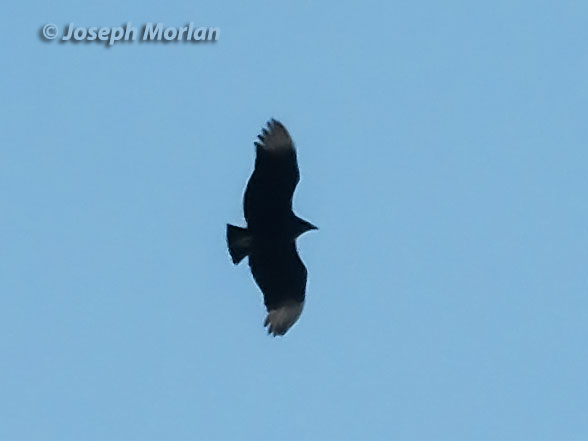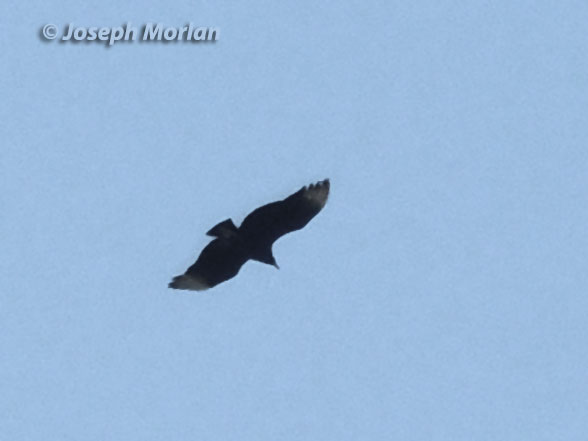Black Vulture (Coragyps atratus atratus)
Pine Gulch Creek, Bolinas, Marin County, CA
01 March 2015
Joseph Morlan
 This
bird was first seen by Courtney Buechert on 31 January and reported regularly thereafter. This morning, Robbie
Fischer and I arrived at the Gospel Flats / Star Route Farm fields along Olema-Bolinas Rd near the entrance of
town and carefully searched the Turkey Vultures roosting in large trees across from a deer carcass. We waited
and watched while all the birds left the roost, but we failed to see the Black Vulture. We met Ron Thorn and Leonie
Batkin and continued to search the sky for vultures with no luck. About 11am, we heard a shout from Bob Battagin,
"Joe, it's overhead!" Looking very high we all saw the Black Vulture sailing from Bolinas Lagoon inland
towards Bolinas Mesa. We had the bird in view for about one minute and I attempted to photograph it with my Nikon
P510 with rather mediocre results as seen here. Much better photos were taken 01 February by Rick Le Baudour here and here.
We learned that Bob Battagin had also seen the Black Vulture near the roost at about 7am this morning.
This
bird was first seen by Courtney Buechert on 31 January and reported regularly thereafter. This morning, Robbie
Fischer and I arrived at the Gospel Flats / Star Route Farm fields along Olema-Bolinas Rd near the entrance of
town and carefully searched the Turkey Vultures roosting in large trees across from a deer carcass. We waited
and watched while all the birds left the roost, but we failed to see the Black Vulture. We met Ron Thorn and Leonie
Batkin and continued to search the sky for vultures with no luck. About 11am, we heard a shout from Bob Battagin,
"Joe, it's overhead!" Looking very high we all saw the Black Vulture sailing from Bolinas Lagoon inland
towards Bolinas Mesa. We had the bird in view for about one minute and I attempted to photograph it with my Nikon
P510 with rather mediocre results as seen here. Much better photos were taken 01 February by Rick Le Baudour here and here.
We learned that Bob Battagin had also seen the Black Vulture near the roost at about 7am this morning.
Description
The following description is based on memory and on photos:
A distinctive short-tailed raptor-like bird soaring very high and directly. At no time did it associate
with the kettles of Turkey Vultures in the air. At no time did I see the bird flap; it just continued across the
sky in a direct line on relatively flat wings. The shape was distinctive with a very short, square-cut tail and
a dark head projecting well in front of the leading edge of the wings. Its body and underwings were solid black,
lacking the two-tone underwing pattern of Turkey Vulture, but instead showing a silvery-gray area near the tips
of the primaries. The wing-tips were relatively broad; photos showing five separated outer primary "fingers."
No details of the head or bill could be determined but my photos seem to show gray legs.

Identification
This is a distinctive species unlikely to be confused with anything else although it bears a superficial similarity
to the Common Black Hawk. In fact I have read speculation that the Common Black Hawk mimics the Black Vulture
while the Zone-tailed Hawk mimics the Turkey Vulture. Personally I think the former is a bit of a stretch. Common
Black Hawk has a bold white band on its tail and a much larger fully feathered head compared to Black Vulture.
Common Black Hawk has black wing-tips with only a small area of whitish at the bases of the outer primaries.
Common Black Hawk also has yellow legs and feet and a yellow cere usually visible from a distance.
Discussion
California has nine previously accepted Black Vulture records. Marin County has no previously accepted records,
however a bird seen in March and April 2014 just to the north in Sonoma County could arguably be the same individual
as this one in Bolinas. In addition unconfirmed sightings of a possible Black Vulture were reported 22 January
in Larkspur and from "about two weeks" earlier in Southern Marin. Whether these could have been the
same bird remains speculative.
Three subspecies are currently recognized. Birds from the United States and Northern Mexico are nominate C.
a. atratus which is replaced by C.a. brasiliensis from Mexico to northern South America (smaller with
bolder pale wing-tips) and by C. a. foetens in western South America (reduced pale area on wing-tips).
Although the species is generally non-migratory, individuals of the nominate race have been expanding their range
northward and into Arizona. It is believed that vagrants in California probably come from this population and
the appearance of this individual is consistent with the expected nominate race.
This bird is an adult based on its pale bill tip and heavily wrinkled head as shown clearly in Rick Le Baudour's
photos cited above.
 This
bird was first seen by Courtney Buechert on 31 January and reported regularly thereafter. This morning, Robbie
Fischer and I arrived at the Gospel Flats / Star Route Farm fields along Olema-Bolinas Rd near the entrance of
town and carefully searched the Turkey Vultures roosting in large trees across from a deer carcass. We waited
and watched while all the birds left the roost, but we failed to see the Black Vulture. We met Ron Thorn and Leonie
Batkin and continued to search the sky for vultures with no luck. About 11am, we heard a shout from Bob Battagin,
"Joe, it's overhead!" Looking very high we all saw the Black Vulture sailing from Bolinas Lagoon inland
towards Bolinas Mesa. We had the bird in view for about one minute and I attempted to photograph it with my Nikon
P510 with rather mediocre results as seen here. Much better photos were taken 01 February by Rick Le Baudour here and here.
We learned that Bob Battagin had also seen the Black Vulture near the roost at about 7am this morning.
This
bird was first seen by Courtney Buechert on 31 January and reported regularly thereafter. This morning, Robbie
Fischer and I arrived at the Gospel Flats / Star Route Farm fields along Olema-Bolinas Rd near the entrance of
town and carefully searched the Turkey Vultures roosting in large trees across from a deer carcass. We waited
and watched while all the birds left the roost, but we failed to see the Black Vulture. We met Ron Thorn and Leonie
Batkin and continued to search the sky for vultures with no luck. About 11am, we heard a shout from Bob Battagin,
"Joe, it's overhead!" Looking very high we all saw the Black Vulture sailing from Bolinas Lagoon inland
towards Bolinas Mesa. We had the bird in view for about one minute and I attempted to photograph it with my Nikon
P510 with rather mediocre results as seen here. Much better photos were taken 01 February by Rick Le Baudour here and here.
We learned that Bob Battagin had also seen the Black Vulture near the roost at about 7am this morning. 